Mike's 9/11 story
Notes from New York- Fall, 2001
 I wrote the following so as to remember the details of my own experiences in the fall of 2001, when our view of the world changed forever. I didn't have the big picture, I had no access to special sources or documents, I didn't even listen to the news as much as some people did. But I did have the opportunity to be involved in a small way in a few of the efforts following the destruction of the World Trade Center. I hope that this account of some of the minor details of the volunteer efforts will not seem presumptuous, trivial or flip, given the magnitude of the tragedy, the thousands of victims, and the many who risked- and in some cases gave- their lives to help. I simply wanted to record my thoughts at the time, and to describe the rapidly and spontaneously formed society of volunteers, drawn from around the world.
I wrote the following so as to remember the details of my own experiences in the fall of 2001, when our view of the world changed forever. I didn't have the big picture, I had no access to special sources or documents, I didn't even listen to the news as much as some people did. But I did have the opportunity to be involved in a small way in a few of the efforts following the destruction of the World Trade Center. I hope that this account of some of the minor details of the volunteer efforts will not seem presumptuous, trivial or flip, given the magnitude of the tragedy, the thousands of victims, and the many who risked- and in some cases gave- their lives to help. I simply wanted to record my thoughts at the time, and to describe the rapidly and spontaneously formed society of volunteers, drawn from around the world.There are a few photos embedded in the text below which illustrate the story. To see more of my photographs taken at ground zero itself during the days following Septermber 11, 2001, click here.
Tuesday, September 11, 2001
I was in Denver, at the annual meeting of the American Academy of Otolaryngology-Head and Neck Surgery. As usual, I only attended those few events to which I am obligated (committee meetings, etc...) and had spent the rest of the time trying to enjoy my new surroundings. I had recently gotten into road biking, so I had rented a bicycle. I had done a century ride (100 miles) in the foothills south of the city on Sunday, and had toured the trails of Boulder on Monday before returning the bike to the shop. I was a little tired and achy, but feeling good. The course that I give each year at the meeting was scheduled for the afternoon.
As I left my hotel that morning to drive down to the convention center, I overheard someone say something like "...it was a little plane... must have been an accident...". I turned on the radio and heard about an airplane hitting the World Trade Center, but the details were sketchy. By the time I had reached downtown Denver, the thing was starting to take form, emerging from the shadows as a recognizable shape. This was something that I had long anticipated and feared, but was now real. The monster's head was coming into view, but we hadn't seen the rest of him. It was still not clear what was actually happening.
I met my partner Peak to go over to the convention center for breakfast, as we had planned. By now feelings of dread have started to surface. We walked over to the center, where Peak ran into his old partner, who was near tears. He told us that the towers have collapsed, taking 100,000 people with them.
The next few hours were very confusing indeed. The strike against the Pentagon was also reported, as was the crash in Pennsylvania. The president was in Air Force One, hopping around the country before returning to Washington. I drove back to my hotel room to pack everything into my rental car, including extra water, toilet paper, as much cash as I can get out of the ATM. I filled up the car with gas- no price gouging as had been reported in some states, no long lines. I returned to downtown, and watched the news from Peak's hotel room. I called home and told Jennifer to get the kids back from school and fill the bathtub in case the water was cut off.
We made plans to leave. It was not clear whether the airports would be functioning by the time of our flights on Wednesday. I was very glad to have a rental car, which had suddenly become a hot commodity. Many people were vying for a space in the little car, and it was not apparent who was going to drive, and who was going to wait for the airports to open. Some of the conference attendees were said to have purchased cars for the drive home. My boss had obtained train tickets for himself and some colleagues. Peak and I decided to wait until tomorrow to see what will happen before leaving. I gave my course that afternoon, and was somewhat surprised by the good turnout. The topic- Internet marketing of medical practices- seemed so trivial and ridiculous at this point. I guess the audience members had nowhere else to go. I drove back to my hotel to sleep, but I kept all of my luggage in the car.
Wednesday, September 12 - Thursday, September 13, 2001
We decided to leave. The atmosphere around rental cars was reminiscent of that around lifeboats- you wanted to help your friends, but you also realized that there is a limit to space and some decisions had to be made. Cell phone communication was erratic, so it was not always possible to connect with those that you have arranged to travel with just the night before. My car was small, and would not be suitable for more than 4 even for a short drive with no luggage. Peak and I have arranged to drive with Diane (a new faculty member), who had been staying at a different hotel. On the way over to the hotel, Adam (a chief resident) flagged us down and asks for a lift to New York. The car is now full.

We packed the car tightly with luggage and food, but there was no room for my garment bag so we mailed it home. Leaving Denver around 10 AM, we head out to the airport to add the other drivers to the rental agreement. Once there, we were happy to find a minivan available as an upgrade, so we transfer the luggage again. The minivan was much more comfortable for the long trip than the compact car I had originally rented, and our spirits were lifted a bit.
For the next 34 hours, the news was a constant companion, although information comes out very slowly. The extent of the attack, the details of cell phone calls made from the doomed planes, the reports of rescue operations, and the investigation of the hijackers slowly came into focus. We passed the time by listening to music, discussing politics, singing, and eating. We stopped to stretch our legs at the Prairie Dog Town near Ellsworth, Kansas, where we saw the world's largest prairie dog and a six legged cow.
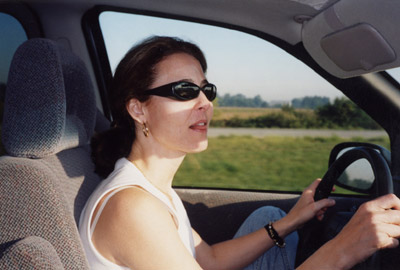 Our route took us straight east from Denver to the border, then across the long state of Kansas. We stopped for a steak dinner in Topeka, then drove on through the night, crossing Missouri and Illinois. Breakfast was at a Steak and Shake restaurant on the Indianapolis beltway.
Our route took us straight east from Denver to the border, then across the long state of Kansas. We stopped for a steak dinner in Topeka, then drove on through the night, crossing Missouri and Illinois. Breakfast was at a Steak and Shake restaurant on the Indianapolis beltway. The drive continued across Ohio, until we paused for lunch in Wheeling, West Virginia. We made good time and didn't stop for dinner until Amish country, in eastern Pennsylvania. We finally rolled into Newark Airport around 10 PM and trade the rented minivan for my car parked in the monorail parking lot.
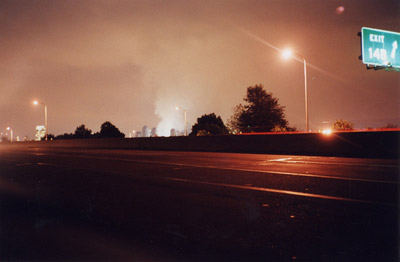 We took a slight detour on the way home to stare across the Hudson at the sight of the rescue lights shining through the smoke in Lower Manhattan. For the first time, this is not just the news. For the first time, this felt real, looking at New York as my town, my home, not just as a place on the TV news. The city had been stabbed in the heart. I was shaken and afraid.
We took a slight detour on the way home to stare across the Hudson at the sight of the rescue lights shining through the smoke in Lower Manhattan. For the first time, this is not just the news. For the first time, this felt real, looking at New York as my town, my home, not just as a place on the TV news. The city had been stabbed in the heart. I was shaken and afraid.I drove Peak home, and then took Diane and Adam to LaGuardia airport, where her car was parked. I got home after midnight and collapsed.
Friday, September 14, 2001
I really wanted to get into the city, to try to help, to breathe the air, to be there. My office hours had been cancelled. I hadn't seen the kids last night, so I drove them to school in the morning and then headed over the bridge.
On the way downtown (there was surprisingly little traffic on the East side highway), I realized that I probably should get some sort of mask if I was going to be near the site itself. I paged Shane (another chief resident) and asked him to grab me a box of masks intended for working with patients with tuberculosis (not realizing at the time that these are pretty much useless in the toxic soup of Ground Zero air). He asked to come along with me. We left the car at Mt. Sinai and took a cab down to the Chelsea pier at 26th street.
Before going into specifics, I should mention that the following days were characterized by an ever changing network of control exercised over the various aspects of the operation. It is not clear, certainly from my street level view, exactly who is in charge of what. Furthermore, it seems that many of the agencies involved were vying for control and giving contradictory instructions to volunteer workers at that point in time. While I will have many different jobs over the early days of the response effort, there is almost never a clear chain of command. Typically, I would just be assigned to a function by whichever person seemed to be in authority. This caused significant difficulty when the time came to request information or interact in some way with people outside the boundary of the simple task at hand. Furthermore, access to the ever more tightly controlled "Ground Zero" is restricted at varying points by various agency to those with varying credentials. At one point, a company of armed soldiers is seemingly turning everyone but the Mayor away, while at another time, there is a lone police officer at the checkpoint asking for nothing more than a photo ID of some kind for any one person in a group!
Over the latter part of the first week, there was a clear transition from a disaster scene where any and all help is eagerly needed and utilized, to a regimented government project in which most of the tasks are delegated to paid professionals. This is, for the most part, a good thing, yet it does tend to frustrate the legions of firefighters who have jumped into their trucks and driven across half the country to get into the thick of the rubble pile. It seems that access is a bartered commodity, built around fluid and rapidly changing alliances with the various organizations involved. The NY Police Department, the NY Fire Department, NY OEM (Office of Emergency Management), FEMA (Federal Emergency Management Agency), the FBI, the National Guard, the MPs, the Red Cross, The Salvation Army, and others all wield different degrees of access and authority. Furthermore, there are aparently unattached people who have simply assumed command, staying very well connected with the local authorities.
Shane and I were not quite sure where to start, but we had heard that there was an aid station at the Javitz Convention Center at 34th street between 11th and 12th avenue, as well as something at the Chelsea Pier on 23rd street. We asked the cab driver to drop us off at 23rd and walked over to Chelsea Pier, an old waterfront dock that has since been turned into a huge sports-themed amusement park that spans many blocks on the west shore of Manhattan.
We found nothing at Chelsea Pier, so we decide to walk south along the river, taking the multi-use bike path that makes up a part of the New York Greenway system. By this point, the path had become home to a long line of news vans, beaming live coverage by satellite to every media company in the world that could afford to send a full time crew to New York. After walking down to Canal street, it became clear that we would not be allowed through the checkpoint. To be sure, we were not really sure what we would do if we were. We walked east along Canal street, pausing to ask police officers and MPs about the possibility of volunteering. None were aware of any such protocol, or were inclined to help us further. A few keep mentioning the Javitz center, so we eventually took the subway up to 34th street.
The situation is just as confusing there, with a large number of people milling around the southern wall of the convention center. We went from agency to agency, asking for directions, until someone announced that all doctors and nurses willing to volunteer should stand in line. We lined up, and a police officer informed us that there is a job to do which is "not glamorous" but is important. We are to help the relatives of victims by taking DNA samples (swabs of the lining of the cheek) to help match body parts with names, to confirm that a person did actually die in the attack. Until this is done, most of the thousands of people who had likely died in the collapse of the buildings were listed as missing. Identification provided closure for the families and allowed for rapid release of insurance money, so an all out effort is needed
Shane and I got into line along with a young nurse from NYU (Robin), a Peruvian nurse who has been working in Italy until recently (Melissa), and a visiting nurse from Wisconsin (whose name escapes me). Also with us was Omar, a general surgeon who recently quit practice at a Manhattan hospital, and who now happily tells everyone that his surgeon wife is supporting him. Omar, as it turns out, has spent some time at Ground Zero in the early days of the rescue operation, a badge of honor in the culture that is springing up among the volunteers.
We arrived at Baruch College on 25th street around 3rd avenue, and were met by an earnest forensic pathologist from Albany, who has been selected to run this project. It was quite clear that there are many more volunteers than are needed, a recurring theme during these days. In any case, we are told about the DNA sampling. It seems that medical personnel have been selected for this task not so much for the procedure (to be done by the family members themselves), but for our anticipated ability to communicate gently with people in great emotional stress.
In any case, the relatives did not materialize that night from the adjacent armory. The start of the process had been deferred until the next morning. While awaiting this decision, we set about collating the necessary documents with zeal- it is the first real work we have been able to do! Once that is done, we were invited to eat with the police officers setting up this station. Again, a recurring theme, the people of New York (and the whole country) have been amazingly generous. We are served a vast array of delicious gourmet sandwiches and desserts for our efforts, and spend an hour or so in conversation with the police.
Around 8 PM, the decision was made that the DNA collection will not happen tonight. We are free to go until tomorrow morning, but at that time other medical personnel will be arriving to do the job. Therefore, a new plan was needed.
Another recurring theme is the frequent formation of little bands of volunteers, moving together in search of an opportunity to serve. So, at this point, I asked Omar if he could lead us to where we might be needed, given his experience. He readily agreed to lead us, and a six person company was formed, consisting of Omar, myself, Shane, Robin, Melissa and the nurse from Wisconsin. We hiked from third avenue across town to the Hudson river. At this point, Omar felt that our best shot was to walk down to Ground Zero (about 3 miles from Baruch college).
We were able to talk our way past the checkpoint at Canal street, no small feat considering that we had to show a police lieutenant various and sundry ID's. While Shane and I had our Mt. Sinai medical photo ID's (which were considered to be very reliable, as we found out later), Melissa had an Italian document with her photo laminated into it, and Omar only had his driver's license and a copy of his non-photo medical license. Nevertheless, we were allowed to walk down to Chambers street, where we were quickly turned away by the MP who told us that volunteers needed to go to Chelsea pier.
 Discouraged, feet hurting, and no longer sure of Omar's leadership, we began the 2 mile walk back up past the line of news vans along the Hudson river. To be fair, it was virtually impossible to predict from one day to the next what you would need to pass a particular barricade. We made it back to Chelsea pier around 11, at which point Shane, Robin and the nurse from Wisconsin decided to call it a night.
Discouraged, feet hurting, and no longer sure of Omar's leadership, we began the 2 mile walk back up past the line of news vans along the Hudson river. To be fair, it was virtually impossible to predict from one day to the next what you would need to pass a particular barricade. We made it back to Chelsea pier around 11, at which point Shane, Robin and the nurse from Wisconsin decided to call it a night.Saturday, September 15 - Sunday, September 16, 2001
Chelsea pier was a beehive of activity late Friday night, with perhaps a hundred volunteers assigned to various jobs. Many had been given the role of security, which they exercised with enthusiasm, guarding the entrance like bouncers at a popular night club. Once again, the medical photo ID seemed to be the passkey that got us in the back, where we were greeted by a friendly and gregarious male nurse (Anthony) who was assigning medical jobs. We were initially told to man the medical aid table in the main room, where hundreds of volunteers, along with firemen fresh from the scene mingled in a kind of raucous bazaar. In addition to the usual groaning food table, there was a supply table, a communications table, a housing table, and other stations designed to make better the lives of the thousands of rescue workers, many from out of town with no place to eat or sleep. The supply table was covered with hard hats, respirators, duct tape, flashlights, tarps, ponchos, clothing, virtually anything that had been donated to the cause. Again, the generosity of people has been amazing, almost nothing seemed to be wanting.
The medical table was mainly there for eyewashing (the most common medical intervention for firefighters who had spent time in the smoky hell hole of Ground Zero). As it happened, virtually no one was in need of aid here, and the table was overstaffed, so Anthony had Omar, Melissa and me move over to the Decontamination station next door.
The "Decon" station was the bailiwick of Dave, a military veteran who had injured his hand at the site and was now delegated to this job "behind the lines". We also had at this station about four college students who acted as runners, escorting the firefighters up to the shower after changing into the donated clothing that constantly filled our area. At one point, a sweet old lady came in to donate a bag of clothing. She spent some time impressing me with the quality of a coat that she was giving to the cause, pointing out that it was, among other things, brand new!
Late in the evening, Omar left and was replaced by Steve, a physician's assistant who had driven up from Baltimore with his emergency van, some medical supplies and a cake which was being enjoyed in the volunteer station next door. Steve was very enthusiastic, and eager to help in any way possible.
Dave was billed as an expert in environmental hazards, and spoke to us at length about the proper method of decontamination of the firefighters' clothing after return from the scene. He was also very aware of the combat fatigue and flashbacks that were common in these situations, and made sure that the returning "soldiers" had a nice, quiet, safe place to chill out after returning from the front. Dave regaled us with stories about his life as a soldier, an epidemiologist, a medical student and a post traumatic stress counselor. Around 3 AM, at a quiet time in the evening, we lay down on the concrete floor on blankets for some sleep.
We woke up around 6, and found that they were in the process of shutting down this particular aid station, diverting the returning fireman elsewhere. So Steve, Melissa and myself walked the 10 blocks up to the Javitz center for reassignment.
We were among the first to arrive at the Javitz center. A woman came up to me and asked me what I did. I told her, and she handed me a clipboard and told me to organize medical teams. This quickly became a very consuming activity, as hundreds and hundreds of doctors, nurses, EMTs and paramedics soon descended on the convention center.
I set one nurse (Bonnie) to the task of registering everyone, getting names, phone numbers and checking credentials. By the afternoon, she had filled an entire lined note pad with names, from all over the country. I started making up teams of 8-10 as requested, but many fire/medic divisions arrived already arranged into teams. Leaders were designated, and about 15 teams of 10-15 people were delineated. We spent the day organizing these people as best as we could, but it was made clear to us at the beginning that the chance of them being needed at the site was virtually non-existent. Everyone wanted to jump in and save lives, and most were very frustrated at being denied access to lower Manhattan. I was as honest as I could be with them, but the truth was that I had no idea how medical personnel needs were being communicated to the Javitz center.
My immediate supervisors were Deb and Lisa, two women who seemed to run everything at that location. It turned out later that they were simply volunteers who had been working there since the beginning, and therefore had made a lot of contacts, but were not affiliated with any particular agency. They were, however, empowered to dispatch teams to the site, which was done only once on that Saturday, when Lisa gave me 2 minutes to fill a bus with doctors and nurses only, much to the consternation of the firemen waiting to rush in and give aid. However, later on in the day a mysterious FBI agent appeared in plainclothes who was apparently running his own separate ferry service to Ground Zero, and was able to ship down a few Humvees full of "lucky" volunteers.
I got somewhat cynical about the whole process, hearing stuff like "hey DOC, what about blue team?!" more times than I can count. From the very beginning, we told them that this was not necessarily the way to glory, and if they wanted to help they could sit around and wait and maybe help move supplies, but no one was interested in doing that for the most part (except for the nurses!). To be fair, these firemen/paramedics must have been very frustrated, having driven up en mass from hundreds or thousands of miles away, sirens blaring, and then being told that all we needed were people to move crates of socks around.
Furthermore, the MPs and State Troopers who were providing security had identified me as being in charge of these teams, so they were constantly calling me out to clear one person or another. "Hey doc..! Is this guy OK?" I would go out and tell the latest endocrinologist or transplant surgeon who was trying to get through the barricades that while the likelihood of his medical training being needed downtown was quite remove, but that he was more than welcome to help with packing and lifting.
 Two of these medical volunteers stood out, though. Robert was a surgeon who went down to Ground Zero early on, but during his time at the Javitz center had been a great organizer and had helped keep the various teams together. David was a firefighter/EMT from Vermont who led his team to help with the hard labor of moving supply crates around without complaining about missing the action downtown.
Two of these medical volunteers stood out, though. Robert was a surgeon who went down to Ground Zero early on, but during his time at the Javitz center had been a great organizer and had helped keep the various teams together. David was a firefighter/EMT from Vermont who led his team to help with the hard labor of moving supply crates around without complaining about missing the action downtown.What was becoming apparent at this point was that the little actual medical care that was needed was becoming increasingly less dependant of volunteer labor. As time wore on, more and more of these functions were being assumed by New York EMS and by the National Medical Disaster teams fielded by the Public Health Service. Furthermore, as the last of the survivors had been pulled from the wreckage on Wednesday, there were few severe injuries to treat, and any that did occur (such as construction type accidents) were quickly whisked away to the area hospitals. Sadly, for the vast majority of those who were not evacuated from the buildings, the wreckage was not so much a prison but a huge tomb, and medical care was sadly in minimal demand.
As it became apparent that there was little need for further organization of medical teams, Lisa and Deb asked me to supervise the supply station at the Javitz center. As I mentioned, the generosity of the country was incredible, and huge surpluses of everything from batteries to baby wipes were everywhere. At this point I began working with Anne, an executive whose husband was the CEO of the Javitz center. She was very organized, and had an understandable amount of clout with the various agencies involved. Anne, Lisa, and I (Deb had gone down to Ground Zero on the medical bus) worked on the supply room until the word came that this station was to be closed down and supply operations moved elsewhere. During this time I also met John, a paramedic who was filling medication supply orders so frantically that I was worried that he would collapse! He had made contacts in FEMA, and had been transferring material to the site for days.
Although I had put in a satisfying day at the Javitz center, I still was hoping (like all those firemen) to get the chance to actually get down to Ground Zero. I realize that all of the jobs are important, but I was still drawn to the site. I can't deny that part of my reason was to see the wreckage with my own eyes, but I also felt that the little bit of medical aid that I had given at Chelsea pier was not in great demand. I had heard reports that the medical teams downtown were understaffed and tired.
By this point, the Javitz center supply depot was shutting down. Deb had returned and was taking over the closure of the depot, and told me that I could go downtown if the opportunity occurred. I had pretty much resigned myself to working here in the supply room for the duration, when Robert appeared and told me to suit up quick, because he was leaving with a small team on a Humvee right away. I grabbed my respirator and hard had, took along Stephanie (a hard working medical student who was also eager to go to the site) and was following him to the loading dock when an unfriendly voice asked me to stop. An official from the OEM had arrived to take control, and wanted to speak with me.
This was one of the many jurisdictional squabbles which arose with regularity. OEM and FEMA and a variety of other organizations were apparently frequently involved in such friction, but I assume that this is just human nature in a confusing situation. This enterprise is a huge undertaking, dwarfing most businesses in its scope, complexity and dangers. However, unlike a business, it had sprung into life within a week with no mission statement or business plan, and the various organizational entities involved were trying to rapidly adapt to changing circumstances.
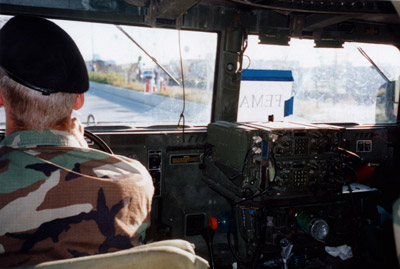 In any event, the upshot of the OEM intervention was that Stephanie and I missed the transport, and I had a frustrating conversation with a bureaucrat about the lines of command, which were not at all clear. It turned out later that this person was quite wrong, and that the CEO of the Javitz center went to bat for us with the Mayor's office regarding the incident. AND, as luck would have it, Robert's team returned for me after all. I grabbed my hard had and respirator once again, and jumped into the back of a Humvee that had "FEMA" on the windshield.
In any event, the upshot of the OEM intervention was that Stephanie and I missed the transport, and I had a frustrating conversation with a bureaucrat about the lines of command, which were not at all clear. It turned out later that this person was quite wrong, and that the CEO of the Javitz center went to bat for us with the Mayor's office regarding the incident. AND, as luck would have it, Robert's team returned for me after all. I grabbed my hard had and respirator once again, and jumped into the back of a Humvee that had "FEMA" on the windshield. We were on our way to Ground Zero at 6 PM. As we drove down the West side highway, we were greeted by the crowds of well-wishers. These people had stood at the barricades for days to shout "thank you!" over and over again to each vehicle that passed, handing cold water bottles and Gatorade through the open windows.
The Humvee dropped us off at the Independence School (PS 234) on Greenwich and Chambers street, a few blocks north of the smoldering pile of steel that had been 7 World Trade Center. Here, a makeshift aid station had been assembled (although it was not quite clear by whom). This was more organization than I had seen before. The station was run by Joe, a graduate of the Yale School of Public Health (verified by his sweatshirt), and staffed by doctors and nurses. The doctor in charge of our first shift was Michelle, a nephrologist. In addition, there were several nurses who had worked together before, John the paramedic and a Chiropractor named Dr. John who ran around giving most welcome spinal adjustments to the rescue workers. We had beds, IV supplies, suture materials, and, of course, gallons of eye irrigation solution.
 The Independence School itself served as a comfortable base of operations for much of this time, having bathrooms, sleeping cots and a large cafeteria well stocked with donated snack food and coffee. There were also a few telephones which had been rigged up to allow for outside phone calls- important since cell phone battery life was severely taxed in this extremely mobile volunteer effort. The entire school was covered in cards, letters and posters made and sent in by kids all around the country.
The Independence School itself served as a comfortable base of operations for much of this time, having bathrooms, sleeping cots and a large cafeteria well stocked with donated snack food and coffee. There were also a few telephones which had been rigged up to allow for outside phone calls- important since cell phone battery life was severely taxed in this extremely mobile volunteer effort. The entire school was covered in cards, letters and posters made and sent in by kids all around the country.I was able to suture lacerations (although the only material available was 3-0 nylon, a bit heavy for fingers). I also got quite proficient at eye irrigation. Other interventions included strapping feet (for plantar fasciitis) and the dispensing of a variety of over the counter medications. At one point, a rescue worker was brought in by stretcher in severe pain from dehydration cramps. Michelle had seen this before, and two large bore IV's were placed, resulting in a dramatic recovery.
John took a delegation at this point to the aid station just around the corner from the site itself, led by a young GI fellow who had been there before. We decided to split our staffing between this more active station and the relatively controlled setting of the Independence school. Back at the school, where things were relatively quiet, I was able to use the cafeteria phones and help myself to dinner from the cases and cases of donuts, fig newtons, tuna fish snacks and pretzels. Furthermore, the air inside the school was fairly clean compared to that at the site, so it was possible to work without a respirator.
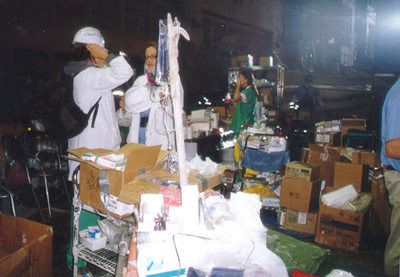 I went down to Ground Zero itself around 10 PM. By this time, the aid station around the corner from the pit had been shut down, but John had scouted out a location directly on the site, just across the service road next to the main pile of wreckage. We set up a new station with cots, tables and racks of supplies on the twisted metal, and continued to treat the workers. One police officer came over for a hand injury, but passed out on sitting down and required an IV and transportation to the nearest hospital. Most of these workers were extremely dedicated, and would not stop for food, drink or rest until they were at the brink of exhaustion. Furthermore, it was very common to see workers right on the scrap pile not wearing their respirators out of machismo or perhaps discomfort. We did our best to tell them how important these were- although asbestos levels had dropped, they were still presumed to be quite high.
I went down to Ground Zero itself around 10 PM. By this time, the aid station around the corner from the pit had been shut down, but John had scouted out a location directly on the site, just across the service road next to the main pile of wreckage. We set up a new station with cots, tables and racks of supplies on the twisted metal, and continued to treat the workers. One police officer came over for a hand injury, but passed out on sitting down and required an IV and transportation to the nearest hospital. Most of these workers were extremely dedicated, and would not stop for food, drink or rest until they were at the brink of exhaustion. Furthermore, it was very common to see workers right on the scrap pile not wearing their respirators out of machismo or perhaps discomfort. We did our best to tell them how important these were- although asbestos levels had dropped, they were still presumed to be quite high.
It was down at this new site that I met Vicki, a nurse anesthetist from Cincinnati that I had actually known years ago during my fellowship! She also had a friend in the field, a nurse anesthetist from NYU named Susan.
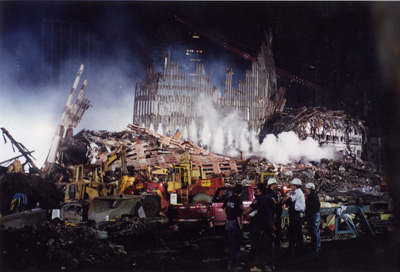
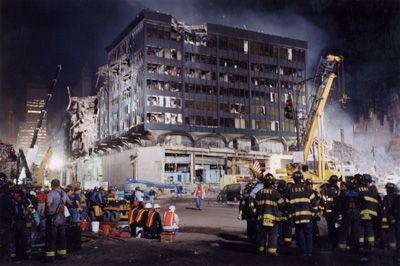
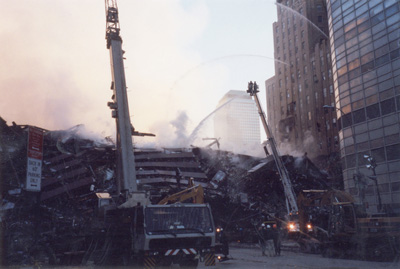 Around 1 AM, Vicki, Susan and I left for the night, and headed up to the Stuyvessant school where the OEM headquarters had been set up. We were going after the elusive and extremely valuable red OEM pass, which would considerably speed up travel to and from the site. Up until this point, we had all had to spend quite a lot of time going through credential checks, with criteria that change by the hour. The red pass, it was rumored, would bypass all that and allow you to get to work more quickly. However, the OEM staff was not passing out these at that point, being in the process of trying to reduce the number of volunteers in the area.
Around 1 AM, Vicki, Susan and I left for the night, and headed up to the Stuyvessant school where the OEM headquarters had been set up. We were going after the elusive and extremely valuable red OEM pass, which would considerably speed up travel to and from the site. Up until this point, we had all had to spend quite a lot of time going through credential checks, with criteria that change by the hour. The red pass, it was rumored, would bypass all that and allow you to get to work more quickly. However, the OEM staff was not passing out these at that point, being in the process of trying to reduce the number of volunteers in the area.
This project had become quite well funded by now (a 40 billion dollar aid package had just been put together by the federal government), and was moving into its chronic phase, which was expected to take months. The authorities were rightfully concerned about having a large number of volunteers with no insurance and varying credentials doing jobs that could now be done by paid professionals. Furthermore, in the event of an emergency (such as another explosion or fire), it would be better to have known teams of city employees who could be rapidly accounted for and evacuated. We understood these things, but still wanted to try to help.
Vicki, Susan and I headed back to the Independence school and the main Red Cross van to try plan B. We had met Will (the Red Cross coordinator) and Raul (another Red Cross official) who had said that they might be able to get us some credentials. While no official laminated passes were available, Raul was able to take our drivers license numbers and print out temporary Red Cross volunteer stickers. He told us to meet him in the morning, and we could exchange these for military passes. Vicki returned to Ground Zero, and Susan and I headed uptown.
Hitchhiking was common in this area, since the only vehicles to pass the tight security perimeter were official and therefore thought to be fairly safe. The second car that passed was a military transport truck driven by a reservist who just happened to be an x-ray technician that Susan knew fairly well..! They exchanged hugs, and we were packed into the back of a crowded, dark troop transport where we were taken to 14th street, the boundary for civilian traffic. We caught a cab and went uptown. Susan lived on 92nd street, and I turned in at the hospital for a few hours of sleep in a call room.
Susan and I had planned to meet at 7 at her apartment, and then go down to find Raul at the Red Cross headquarters to get our passes. She called me at 6, to say that during the night some agency (OEM? FEMA?) had closed down their operation in the process of turning all medical support over to NY EMS. Vicki had gone to the airport to fly back to Cincinnati, and I decided to head home.
Monday, September 17 - Tuesday, September 18, 2001
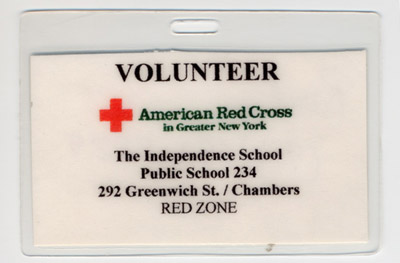 I went to work, going to clinic in the morning and doing two short cases in the afternoon. By 3, I was on my way back downtown. I had only my hospital ID and my Red Cross volunteer pass, which had been printed and crudely cut out with trauma shears in the back of the van last night. Before leaving the hospital, I had stopped at the security office and had them laminate my pass, to make it a seem a bit more official.
I went to work, going to clinic in the morning and doing two short cases in the afternoon. By 3, I was on my way back downtown. I had only my hospital ID and my Red Cross volunteer pass, which had been printed and crudely cut out with trauma shears in the back of the van last night. Before leaving the hospital, I had stopped at the security office and had them laminate my pass, to make it a seem a bit more official.At the Javitz center, chaos continued to swirl, although some degree of organization had begun to take hold. I was happy to see Deb and Lisa once again, and they were schmoozing with the MPs and basically running the operation without any official titles. I ran around for a while helping with supplies while trying to develop a plan for getting back to the site, but this seemed all but impossible. Even Deb and Lisa, who evidently held the keys to the city in this little corner of the world, were asking me to try to get them access badges. Anne was back, and her husband once again thanked us for our efforts and assured us that the official who had hassled us in the past was no longer a concern, thanks to his efforts.
 As night began to fall, it seemed that the only hope of getting downtown was to go up to pier 91 at 54th street, where many of the agencies had set up their offices. FEMA seemed to be the agency to try first, so we headed uptown. With me was Lottie, an LPN from Wisconsin who had come to New York to use up her vacation week when the news of the disaster hit, bringing along her husband and daughter to help in any way possible. Also with us was a Mexican woman who spoke no English, but who possessed an obvious determination and a laminated photo ID identifying her as a surgeon.
As night began to fall, it seemed that the only hope of getting downtown was to go up to pier 91 at 54th street, where many of the agencies had set up their offices. FEMA seemed to be the agency to try first, so we headed uptown. With me was Lottie, an LPN from Wisconsin who had come to New York to use up her vacation week when the news of the disaster hit, bringing along her husband and daughter to help in any way possible. Also with us was a Mexican woman who spoke no English, but who possessed an obvious determination and a laminated photo ID identifying her as a surgeon.  Pier 91 was also the center for families of the victims, with grief counselors, aid agencies and a variety of other services. A long wall near the pier was covered with posters of the missing.
Pier 91 was also the center for families of the victims, with grief counselors, aid agencies and a variety of other services. A long wall near the pier was covered with posters of the missing.After walking up to 54th street, we made it through several doorways until we got to FEMA central, where a polite young bureaucrat informed us that no passes were to be had just now. I recognized him as the same young man that had turned us down at the Stuyvessant school on Saturday night. There did not seem to be any point in arguing.
Ready to turn in for the night, we started to walk downtown again, past the huge Naval ship USS Comfort, which had beds and showers for 2000 workers. We passed the long bulletin board covered with photos of the missing, posted in desperate hope that a loved one had, somehow, survived the collapse of the towers and was lying unidentified in a hospital bed somewhere. And then we came to a big red and white Red Cross truck parked next to a sleepy looking pier office.
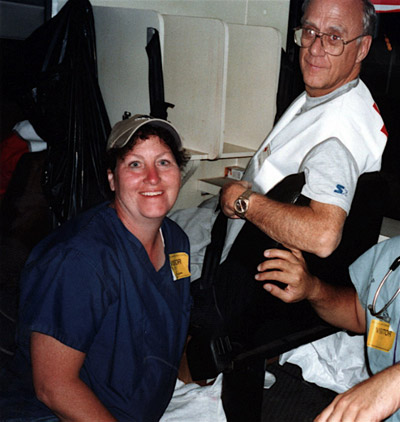 We decided to go inside, but were unable to convince the security guard to let us speak with the three Red Cross volunteers who were packing up their water distribution station for the night. We explained that w e had been working with the Red Cross, and wondered if they knew how we might get back down to the station at Independence school. To our surprise, they simply said "Oh, you want a ride downtown? Sure, hop in!". They simply drove us to the school, right past the same barricades and MPs who were turning away police cars and Humvees for not having high enough clearance! They dropped us off near the school and headed off into the night.
We decided to go inside, but were unable to convince the security guard to let us speak with the three Red Cross volunteers who were packing up their water distribution station for the night. We explained that w e had been working with the Red Cross, and wondered if they knew how we might get back down to the station at Independence school. To our surprise, they simply said "Oh, you want a ride downtown? Sure, hop in!". They simply drove us to the school, right past the same barricades and MPs who were turning away police cars and Humvees for not having high enough clearance! They dropped us off near the school and headed off into the night.At Independence school, the scene was very different. The small, efficient hospital set up in the gym on Saturday night was gone, and the only vestige was an eye wash station set up by the Red Cross right outside. Things were pretty quiet here at this time of the night, so Lottie and I decided to head for Ground Zero with a bag full of eye wash, Tylenol, Motrin, bandages, and other medical sundries.
We found a large Red Cross sign near the Salvation Army table. The Salvation Army folks were happy to give us an empty table, so we set up shop next to them. Still, though, most of these macho firemen and cops didn't seem to want to stop by for health care. We found two Red Cross volunteers, Peter and Mike who were bringing cold water right onto the rubble pile for the workers. We teamed up with them and carted our medical supplies along with the three large coolers of ice and water bottles, and spent the next few hours mingling with the bucket brigades distributing drinks to the workers. The dust was starting to settle, and eye wash wasn't selling as quickly, but chapstick was in strong demand. In fact, I only could find one stick, so I had to slice off little pieces with a butter knife for distribution!
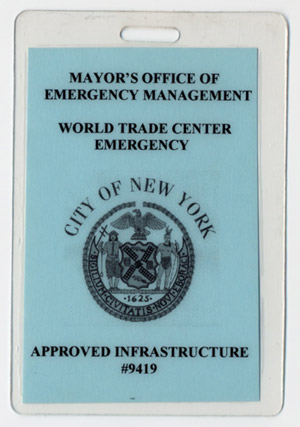 Eventually, we went back to Independence school and caught a few hours sleep on the cots in the hall. I woke early to get the next level of pass, which was rumored to be distributed by the Army a few blocks away. After a little hassle, I was able to get my blue OEM infrastructure pass. While not as useful as the red pass (which apparently did not expire at any particular time), it was a step closer, and the cheerful soldier told me to return at 10 for an upgrade to the red badges which would be forthcoming at that time.
Eventually, we went back to Independence school and caught a few hours sleep on the cots in the hall. I woke early to get the next level of pass, which was rumored to be distributed by the Army a few blocks away. After a little hassle, I was able to get my blue OEM infrastructure pass. While not as useful as the red pass (which apparently did not expire at any particular time), it was a step closer, and the cheerful soldier told me to return at 10 for an upgrade to the red badges which would be forthcoming at that time. I went back to the school and ran the medical station there at the Red Cross tent for a few more hours. More eyewash was needed this morning, and I also had the opportunity to perform a medical intervention which was actually related to my specialty (ear, nose and throat). One of the bomb-sniffing dogs was suspected of having nasal irritation from days of breathing in the dust and debris.
He was something like a German Shepherd, but with an oversized head, and paws that met his legs at odd angles. He was, however, extremely friendly and let me examine the inside his nose.
 To the limits of the equipment that I had available, I saw no foreign body, but I recommended that his person wash out his nose with saline. She thanked me, but said that she would have to do that at the end of the shift, as the saline would interfere with his olfactory duties...
To the limits of the equipment that I had available, I saw no foreign body, but I recommended that his person wash out his nose with saline. She thanked me, but said that she would have to do that at the end of the shift, as the saline would interfere with his olfactory duties...Lottie, of whom I had lost track during the night, reappeared at this point, towing her husband and daughter. Also reappearing was the Mexican surgeon, ready to work. The three of us made it back to the military base at 10, but at this point the lieutenant informed us that the whole system of badges was going to change, and that no red badges would be distributed at all. I decided to call it a shift, and walked north along the west side highway until I was able to hitch with a traffic cop up to 42nd street where I caught a northbound cab to my car at Mt. Sinai.
Friday, September 21, 2001
A perceptible shift in the nature of the project occurred over the first two weeks. After the initial shock of September 11th, a the decision was quickly made that the site was safe enough for emergency workers to return, and a frantic rescue effort was undertaken. This rescue phase- in which survivors were sought beneath the rubble- involved the meticulous removal of debris, largely by hand. A variety of techniques were employed to find survivors such as endoscopic cameras, thermal scanners and specially trained dogs that could locate people (or explosives) by scent. Since time was clearly of the essence, the workers pushed themselves to the point of exhaustion. Unfortunately such efforts, no survivors were reported to have been found after Wednesday the 12th.
Despite the lack of any signs of life, and the decreasing likelihood of anyone surviving for long in these conditions, there was a strong disinclination on the part of the authorities to halt the rescue phase of the operation. Partly, this was an emotional decision- the sliver of hope which characterized a rescue operation gave comfort to the families of the victims, who put up missing posters by the thousands all over the city. Furthermore, given the vast magnitude of the disaster site, and the deep (somewhat protected) underground layers, the possibility of sizeable voids in the rubble was still present. Theoretically, a person in such a void that had not been exposed to intense heat, and that was near some source of water, might have been able to survive for a considerable length of time.
 In any event, by the time I returned to work on Friday, there were no more bucket brigades. Even though the entire site was still swarming with police officers, firemen, and military personnel of all types, the atmosphere was more like that of a huge construction site, where the spotlight had shifted to the ironworkers using massive cranes and flatbed trucks to haul away countless tons of steel, cut into pieces by an army of welders. Even if the official pronouncement had not been made, it seemed that the rescue phase was over and the recovery phase (looking for human remains) had begun. It was clearly disheartening to those who had worked so long and hard in hopes of pulling a miracle from the wreckage of the World Trade Center. Even the dogs were affected- I was told that fake rescues had to be staged at intervals to keep them from getting depressed and losing the will to continue with the search.
In any event, by the time I returned to work on Friday, there were no more bucket brigades. Even though the entire site was still swarming with police officers, firemen, and military personnel of all types, the atmosphere was more like that of a huge construction site, where the spotlight had shifted to the ironworkers using massive cranes and flatbed trucks to haul away countless tons of steel, cut into pieces by an army of welders. Even if the official pronouncement had not been made, it seemed that the rescue phase was over and the recovery phase (looking for human remains) had begun. It was clearly disheartening to those who had worked so long and hard in hopes of pulling a miracle from the wreckage of the World Trade Center. Even the dogs were affected- I was told that fake rescues had to be staged at intervals to keep them from getting depressed and losing the will to continue with the search.I now was fairly familiar with the routine to pass the increasingly tight security at the newly erected fences which had replaced the police barricades. Lower Manhattan had reopened for business, although outside traffic was still stopped at Canal street. Residents of the neighborhoods surrounding Ground Zero were given passes to enter, as were business owners and others whose jobs took them to this area. The few blocks immediately adjacent to the site itself were still only open to those working on the disaster itself. The Red Cross center at the Independence school was where I started work, and was just inside the inner perimeter. I found that I could simply show my blue tag and my hospital photo ID to the guards at the gate, point to the Red Cross tent and be admitted without difficulty.
I headed downtown after work and made it down to the fence by around 7 PM, having walked from Canal street where my cab was stopped. The walk through Tribeca was very peaceful, on a warm September evening where there was little car traffic. Many of the restaurants had reopened and were serving al fresco, with the smoldering heap to the south serving as an odd backdrop to the sophisticated urban sidewalk dining scene.
At the tent, I met several of the Red Cross volunteer coordinators that I had worked with before, as well as Pam, a pediatrician from Mt. Sinai. Later on, this evening shift was replaced by three nurses from Long Island Jewish hospital- Judy, Marne, and Stephanie- who I had met when the aid station had been open on Saturday night. We did the usual stocking and organizing of the first aid table, handing out decongestants, throat lozenges, motrin, insoles and foot powder, as well as irrigating eyes and padding foot sores.
I had come up with a fairly useful routine by now. At Ground Zero, there were all sorts of supplies, food and drink piled at various peripheral stations, a fairly long walk from where the actual work was taking place. I would go over to the Salvation Army station, which was relatively elaborate with several large trucks, tents and a dining area under an inflatable shelter. They were happy to give me a milk carton which I filled with cold drinks from the heavy coolers. I also took along an eye wash bottle, and some minor medical supplies. Most of the people at work on the pile were happy to have a drink or an eye wash without making their way to the outer stations. I would pass through the site, and end up at another outside comfort station run by a group of ministers, who would fill up the milk crate again for another pass back through the work site. I made several runs like this during the night, usually with one or two of the nurses.
By around 3 AM, I turned in for the night on one of the cots in the Independence School. I slept for around 3 hours, and woke up in the early morning. I was able to hitch a ride north again, this time with a contractor who had come down from upstate New York to repair the phone company's trucks, which were apparently being used up at a prodigious rate. He dropped me at 42nd street, and I found a cab back to my car at Mt. Sinai. I stopped in a South American restaurant on the upper West side for a breakfast of cafe con leche, yucca and plantains, and headed home.
Late September, October and November, 2001
By this point, freelance volunteer labor was not particularly welcome downtown, and it became apparent that the only way to continue helping was to join up with an official relief organization. I decided to go through the American Red Cross, which was still providing food, first aid, and other supportive care to the armies of construction workers, firefighters, police officers and military personnel at Ground Zero.
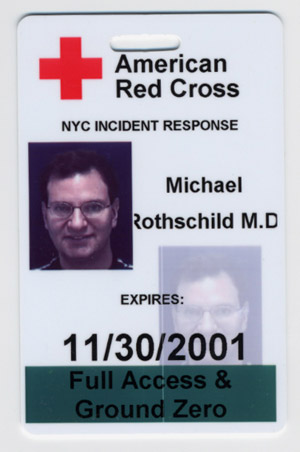 I made my way down to the Brooklyn Red Cross headquarters. Being just across the Brooklyn Bridge on Camden Plaza, it was the main staging area for Red Cross personnel who had come in from around the country for three week shifts. Almost everyone working there and at the site was from out of town, many having never been to New York before. I found that my medical ID was very much appreciated here, and I was quickly sent up to DHS (disaster health services) for processing. They took my name and contact information, and told me to check with them the next day for an assignment. I went downstairs and got the official Red Cross badge of honor, a photo ID with "Full Access & Ground Zero" printed across the bottom.
I made my way down to the Brooklyn Red Cross headquarters. Being just across the Brooklyn Bridge on Camden Plaza, it was the main staging area for Red Cross personnel who had come in from around the country for three week shifts. Almost everyone working there and at the site was from out of town, many having never been to New York before. I found that my medical ID was very much appreciated here, and I was quickly sent up to DHS (disaster health services) for processing. They took my name and contact information, and told me to check with them the next day for an assignment. I went downstairs and got the official Red Cross badge of honor, a photo ID with "Full Access & Ground Zero" printed across the bottom.I had also signed up for courier work, getting a shift assignment right away. The courier service involved driving Red Cross vans around the city, shuttling out of town workers from their hotels to the site, bringing laundry to and from the aid stations, and basically being an errand boy for the whole organization. I enjoyed this job- I had always imagined being a New York cab driver... I spent a useful night driving around the city, passing through the various checkpoints with my new ID card.
Actual medical care at the scene was being delivered by rotating National Medical Disaster System (NMDS) teams. These were preorganized teams of doctors, nurses and other medical professionals assembled through the Public Health Service. Something along the lines of the army reserves, these volunteers were trained to come into an area on a transport jet or tractor-trailer, set up a completely self sufficient medical station and operate without any assumption of basic services (such as power or water) for up to 72 hours. Typically activated during hurricanes or earthquakes, each state has several such teams ready to leave their practices on 48 hours notice.
Every state had been taking shifts supplying basic medical care to the site. I had the opportunity to speak with a very nice ER doctor from St. Louis (on detached service to the Iowa team). Most of the care given by the NMDS was fairly simple and triage oriented, given the close proximity of the many New York hospitals. He did tell me that they had treated a worker who had been shot in the face by a discharging gun that was lying in the rubble pile. Given the nature of the attack, the pile contained virtually everything that would have been in the massive World Trade Complex on any given day, including police officers' weapons, medical material, and a cache of several hundred millions of dollars worth of gold bullion from a bank vault!
Despite the fact that the NMDS teams were providing the "real" medical care, the Red Cross was very happy to have me permanently attached to their first aid station at one of the Respite centers. Respite One was set up in the first two floors of St. John's University on Murray and West street. A cafeteria had been staffed by professional chefs volunteering their services, with meals being served by volunteers. The American Massage Therapy Association has a program called "MERT" (massage emergency response teams), which have apparently been providing massages in such situations for over a decade. There was one room with easy chairs, TV, video games, and a dozen computer terminals with Internet access for the workers to use.
I staff the first aid room, where eyewash, bandages, antacids, throat lozenges, hand lotion, foot powder, and a sea of cough, cold and headache remedies are available for the workers. Anyone who is in need of more than basic first aid was sent over to the NMDS tent. One panicked architect from out of town told me that he had just leaned with his palm on some white debris on a subway bench, and wanted me to tell him that it wasn't anthrax... I reassured him as best as I could.
 Business comes in waves, at some times, there are lines of people waiting for wound care, motrin or decongestants. Other times, things are slow and we passed the time by writing letters back to the children who had written in from all over the country. Thousands of letters piled up in the Respite center daily, many giving their school addresses and asking for a reply.
Business comes in waves, at some times, there are lines of people waiting for wound care, motrin or decongestants. Other times, things are slow and we passed the time by writing letters back to the children who had written in from all over the country. Thousands of letters piled up in the Respite center daily, many giving their school addresses and asking for a reply. One of the best things about working in the first aid station was that you had the chance to chat with people as they came by, and to learn about all of the various jobs that were being done by specialists from around the country. Cops, firefighters, secret service, FBI, as well as telecommunications, sewage, sanitation, gas and electric workers all have their own stories to tell.
Ground zero has become something of a celebrated tourist spot as the weeks and months go on. Every day, there are crowds at the red zone barricades, craning their necks for a glimpse of the wreckage beyond the fences, cameras ready and camcorders rolling. The police officers who man these barricades take on the roles of nightclub bouncer and tour guide. They stand for hours at their posts, answering the same questions again and again, politely but firmly, letting the occasional worker with credentials to pass through. People come to mourn and to remember, but many just to satisfy the universal human curiosity that draws us to train wrecks. For some out of town tourists, the view from the fences must be a more abstract experience, sort of like touring Beirut or Kosovo.
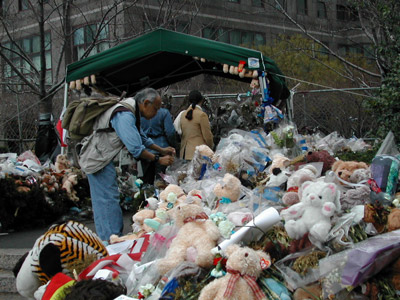 There are other sites to visit- less dramatic than the rubble that still smokes two months after the attack- but far more human and poignant. Spontaneously created memorials are found all around lower Manhattan, at fire houses, at the fences and in on Liberty Street near the river, across the street from Ground Zero. This last site is one of the biggest- the "teddy bear wall". The wall is a shrine made of hundreds of teddy bears, flower bouquets and posters of the missing, where people come to spend a little quiet time with those who are gone.
There are other sites to visit- less dramatic than the rubble that still smokes two months after the attack- but far more human and poignant. Spontaneously created memorials are found all around lower Manhattan, at fire houses, at the fences and in on Liberty Street near the river, across the street from Ground Zero. This last site is one of the biggest- the "teddy bear wall". The wall is a shrine made of hundreds of teddy bears, flower bouquets and posters of the missing, where people come to spend a little quiet time with those who are gone.At this point (late November), there is talk of the respite centers being closed down and of the out of town Red Cross workers being sent home. I continue to go down there when I can, but as the pace of work slows, the need for volunteer support also diminishes. Although the Red Cross has had some public relations problems over the distribution of funds, I am amazed at how the organization has adapted to the crisis, handling over half a billion dollars worth of donations and mobilizing volunteer support from around the country. This is different, though, from other disasters, in that it may never really be "over". This is not like a hurricane or an earthquake. We are now entering into that oxymoron, the "chronic state of crisis". The armed forces continue to level the Taliban infrastructure, and other factions assume control of Afghanistan as I write. But we will never be able to bomb our way back to September 10th. We are in this for the long haul. I hope that we are ready.
